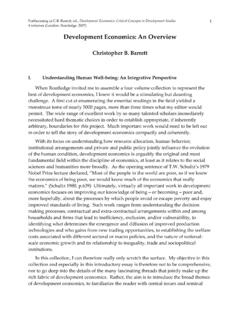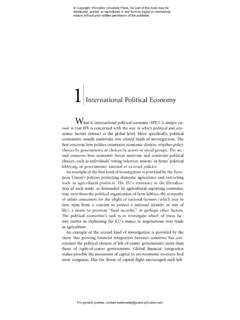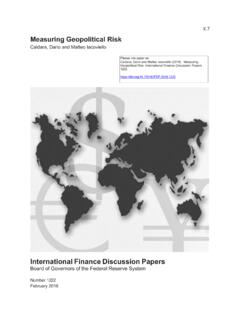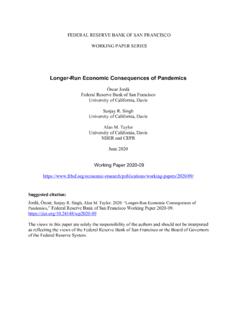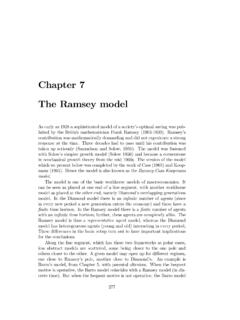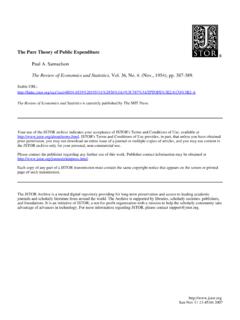Transcription of What is Impact Assessment? - OECD
1 1. The nature of Impact analysis Impact analysis is a component of the policy or programming cycle in public management, where it can play two roles: Ex ante Impact analysis. This is part of the needs analysis and planning activity of the policy cycle. It involves doing a prospective analysis of what the Impact of an intervention might be, so as to inform policymaking the policymaker s equivalent of business planning; Ex post Impact assessment. This is part of the evaluation and management activity of the policy cycle. Broadly, evaluation aims to understand to what extent and how a policy intervention corrects the problem it was intended to address. Impact assessment focuses on the effects of the intervention, whereas evaluation is likely to cover a wider range of issues such as the appropriateness of the intervention design, the cost and efficiency of the intervention, its unintended effects and how to use the experience from this intervention to improve the design of future interventions.
2 Trying to maintain a strict boundary between ex post Impact assessment and evaluation is probably not useful except for didactic purposes. Probably, the majority of Impact assessments can contribute to addressing broader evaluation questions, and in many evaluation designs Impact assessment is used together with other evaluative techniques in order to reach conclusions. A significant danger, however, is to confuse Impact assessment and evaluation because (a) an Impact assessment is not designed to answer as many questions as an evaluation, so it will have nothing to say about many things that matter in policymaking and (b) Impact assessments tend to focus on a narrow and tightly-defined set of impacts, frequently presenting a rather narrow picture of the results of an intervention. This is especially the case where Impact assessments focus overly on economic impacts.
3 The nature of Impact assessments as part of the policy cycle also means that they are inherently not neutral measuring instruments . They can cause observer effects where the fact of observation leads to changes in the things being observed. Especially important here are Hawthorne effects , where the fact of observation tends to induce performance improvement. This is most clearly the case in performance-based research funding systems, which are these What is Impact Assessment? 2 days being extended to cover the impacts as well as the quality of research. These things in turn mean that Impact assessments can themselves be used as policy interventions. Impact assessment is, in more than one sense, a theory-based activity. First, inherently it involves establishing a theory of change , a programme theory or intervention logic in other words, a description of the cascade of cause and effect leading from an intervention to its desired effects.
4 There are multiple terminologies, but the essence of Impact analysis is to establish such a supposed chain of causation ( theory ) from intervention to Impact and to measure or describe the changes induced along that chain. This approach has the advantage of specificity and focus but also tends to limit observed effects to categories that have been predicted, by definition omitting unexpected effects, including perverse or undesirable effects that had not been anticipated by the designers of the intervention. Second, a theory of change itself builds on theoretical preconceptions. For example, a theory of change building on the idea of innovation systems would emphasise the role of context, complementary actions by different stakeholders and the effects of lock-ins, while a neoclassical economic approach would focus on economic incentives and signals, individual economic actors and assume that economic agents can easily change aspects of the production technology or the broader knowledge base upon which they rely.
5 Impact assessments can therefore focus on one set of potential effects at the cost of others without this necessarily being obvious to the observer. Without a determined effort to experiment with the (theoretical and other) assumptions we build into theories of change, the theoretical preconceptions of those who undertake them risk limiting their findings. While evaluation and Impact assessment in research has tended to be disconnected from theory and practice in other fields, the influence of innovation systems thinking has encouraged its (implicit) philosophical basis to converge with that of realist evaluation , which is increasingly the normal approach in the wider evaluation community. Realism is a school of philosophy. It was developed to sit between positivism ( there is such a thing as the real world, which we can directly observe and about which we can derive facts ) and constructivism ( since all our observations are shaped and filtered through the human senses and the human brain, it is not possible to know for certain what the nature of reality is ), Westhorp, 2014.
6 Strictly, realistic evaluation is a particular school within the theory-based tradition. Key ideas from realism that influence how theories of change are constructed, and therefore the kind of evidence that is used, include: Realism asserts that both the material and social worlds are real in the sense that they cause effects; All enquiry involves seeing the world through particular theoretical lenses so there is no final truth or knowledge; 3 Social systems are open systems. Hence, a programme interacts with its context and its systemic role has to be considered; the boundaries of the system to be evaluated are not given but must be chosen by the evaluator; and the relevant systems and boundaries may change over time; Causation results from the interaction of an intervention and its context. (The role of the context may be hard to observe without doing comparative analysis of similar interventions in different contexts.)
7 ; Context affects which Impact mechanisms operate and whether they These points converge strongly with some of the key implications of the innovation systems perspective, notably the importance of context in effecting change, the uniqueness of individual innovation system contexts so that best practice lessons cannot simply be transferred from one to another , the importance of people and institutions and therefore of behaviour and perception in determining outcomes; and the interdependence of system components, which therefore co-evolve to generate different ways to solve similar problems without it being clear that there is one optimum solution. 2. The idea of Impact is itself problematic Traditionally, we refer to the Impact of research on society as if there were a simple, linear relationship between the two. At the same time, the history of the relationship between research and society conventionally referred to as the social contract between science and society twists and turns.
8 The idea of Impact makes obvious sense in a linear model, where changes in research are expected to be the causes of changes in society. The linear idea was important in the Post-War period but has not been so central before or since. Under other social contracts, where the initiative for change comes from society itself, the idea of Impact of research on society appears less coherent. Arguably, the arrow of causality can go the other way. Current theories of innovation also stress the non-linearity of the innovation process and its dependence upon the surrounding system of innovation, the institutions, actors and wider social context within which innovation happens. This suggests there is variety in the mechanisms that link research activity with social change. A single Impact model will in any case not do.
9 The idea of a self-steering research system that impacts the rest of society in various ways is a relatively new construct, dating from the years after World War II. Taking a longer time horizon reveals evolution in the social contract between science and society: namely, the terms upon which society is willing to sponsor or fund science. Rather than research being an 1 These five points are summarized from (Westhorp, 2014). 4 independent variable and Impact a dependent variable, as we like to model the relationship in economic Impact analysis, the social contract has often involved an instrumental attitude to research, which has been expected to act as the handmaiden to society. The medieval universities that emerged in Europe from the Twelfth Century onwards focused on training the medical and legal professions and on educating people for the church2.
10 Monarchs and the church funded these institutions. The universities had few resources for research but produced human capital for a society that was cautious about what we would today describe as scientific progress, since this could bring conflict with established religious and social power structures. From the Seventeenth and Eighteenth Centuries, new specialised higher education institutions and academies arose to develop knowledge and produce human capital for areas such as medicine, artillery and agriculture. Funded by lay groups within society, these were less intellectually constrained than the universities but nonetheless more orientated towards scholarship than research. The Humboldtian revolution, enshrined in the creation of the University of Berlin in 1810 and involving the integration of research into universities and at least in principle the idea that academics should be free themselves to choose their own research topics, is generally held up by the academic community as defining a golden age, where academics governed themselves.










